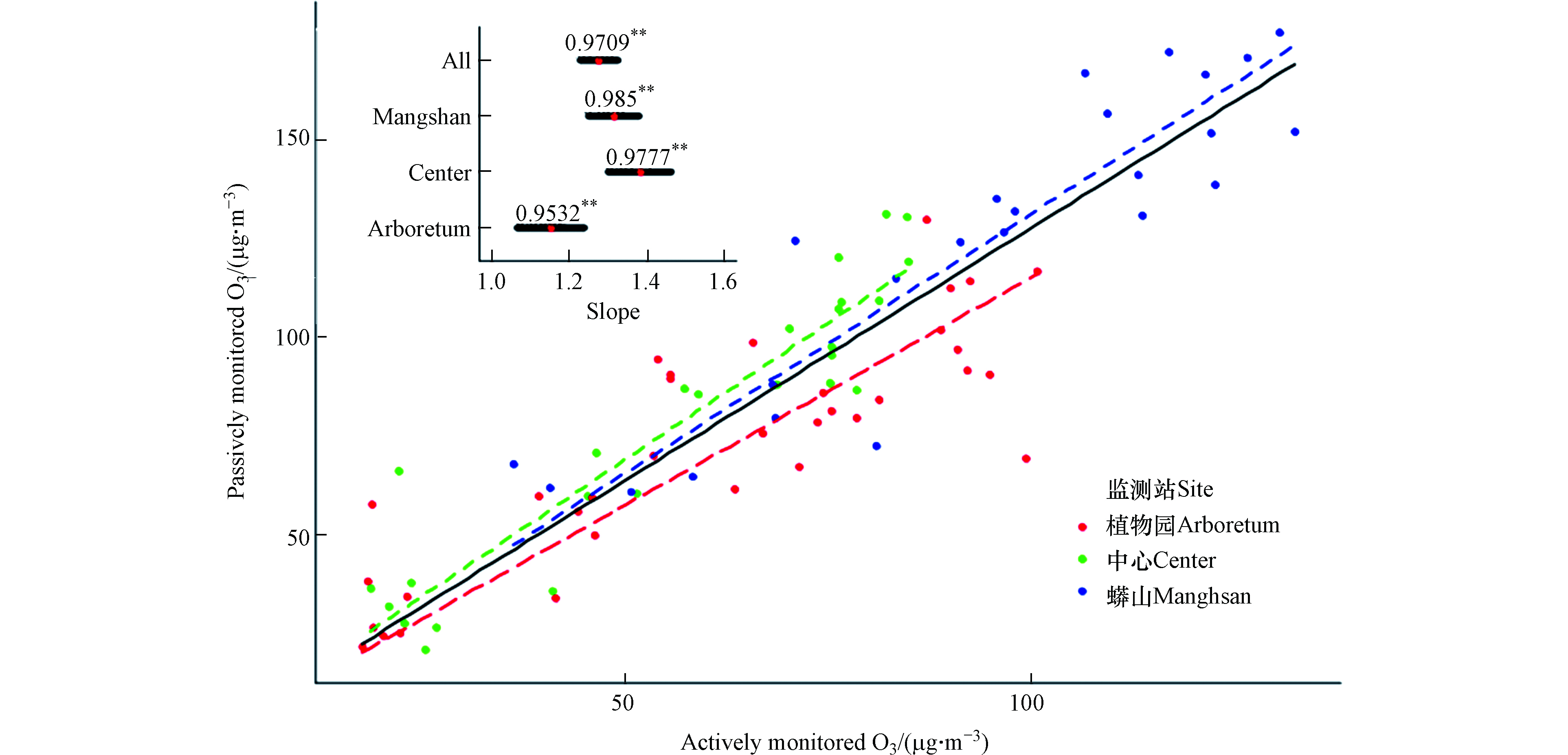-
空气臭氧(O3)污染已经成为我国许多地方的首要污染物,其对人体健康、粮食安全和生态安全的威胁正在引起社会高度关注。由于O3是一种活性强、氧化性高和寿命短的空气污染物,具有很大时间波动和空间变异。监测数据不足是影响深入了解O3污染物浓度特征、变化规律和传播途径,评价O3污染对气候、生态和人体健康等影响的重要瓶颈之一。空气O3监测方法包括主动(采样)监测方法和被动监测方法。主动监测是采用动力装置抽取一定体积的空气,通过化学液体吸收,分析其吸收液浓度(即化学吸收法)或通过测定其对紫外线的吸收量和光电信号转换,记录电信号(紫外光度法),得到空气中的O3浓度值。目前国家和地方空气质量监测站采用多为O3紫外光分析仪,其使用方便,并且能够实现在线实时监测,但也存在仪器价格昂贵、体积大,需要稳定的供电和良好的防雨保温等基础的外围辅助设施,必须要对监测仪器定时开展标定、校准、维护。进行大范围尺度长时间的监测,特别在偏远地区,采用主动监测方法存在很大困难。采用低成本、高可靠性的O3被动监测方法,对开展大范围、大空间分辨率和偏远地区的O3监测及其生态危害研究具有重大意义。
O3被动监测法是基于分子扩散和渗透原理,将空气中O3吸收或吸附到收集媒介,然后分析收集介质上化学物质量,计算出空气O3浓度值。该方法具有体积小、质量轻、占地空间小、不需要外接电源和进气管路、监测浓度范围大、操作简单、不需要特别的技术人员和标定维护且价格便宜,就能够方便地应用于大空间区域范围、长时间和高密度的污染监测。早在1853年,国外学者就采用被动监测方法监测空气O3浓度[1]。经过100多年的发展,O3被动监测方法的到广泛使用。例如,世界气象组织开展的全球50个站点O3观测[2],欧洲科学家开展的O3观测,美国加州对不同下垫面O3观测[3]及加拿大不同尺度的森林O3暴露水平的研究[4]。我国科学家从上一世纪90年代也纷纷研制和推广O3被动监测。20世纪90年代初有文献报道了分别对市内10种常见气体污染物进行监测的被动采样器[5-7];陈乐括等[8]利用自己研制的被动采样器进行了对高纬度地区和北京地区的SO2、NO2和NH3进行了监测[9];近年来,一些国内科研工作者利用被动采样器方法对北京及其周边地区的SO2、NO2、O3和NH3等主要污染物进进行了监测研究[10]。赵阳等采用采用被动扩散采样技术在珠江三角洲 200 km×200 km网格区域内测量了空气SO2、NO2和O3浓度水平[11]。
尽管O3被动监测方法具有很多优势,但其观测精度和可靠性较多受到质疑。因为在被动监测过程中,没有严格控制气体流量,并需要较长的采样时间。可能有许多因素会影响收集介质对O3的吸收,如空气实际O3浓度和空气温湿度、风速等气象因素[12]。以前也有一些有关O3被动监测方法精度和可靠性的研究,但大部分是在实验室条件下或野外条件下的短期研究。本研究在北京城市生态站的3个空气质量长期监测点,于2012—2017年同时采用O3被动采样分析监测法和O3分析仪在线主动监测法,开展了空气O3浓度观测,拟回答以下问题:(1)O3被动监测法和主动监测法观测到的O3平均浓度是否具有很好的线性相关性?并且这些相关性是否会受到监测地点和气象条件的影响?(2)O3被动监测法观测到的平均O3浓度能否很好地分辨出不同观测点的O3浓度差异,为作为开展大范围高空间分辨率的区域O3浓度监测的可靠监测方法。
全文HTML
-
本研究监测地点为中国科学院北京城市生态系统研究站的3个空气质量监测点:北京教学植物园、中国科学院生态环境研究中心、昌平蟒山国家森林公园。分别位于北京市的市中心、四五环间和远郊区,具有不同的城市化程度和空气质量浓度差异化。北京教学植物园监测点位于东城区东南二环内的北京市教学植物园其地理坐标为:(116°25′39″,39°52′22″),海拔约54 m,南方距离二环主干道约300 m,周围植被覆盖率约80%。生态中心监测点位于中国科学院生态环境研究中心院内综合科研楼楼顶其地理坐标为:(116°20′15″,40°00′26″),海拔约76 m,西北方向距离交通主干道双清路300 m,其他方向是植被和建筑物镶嵌的格局,植被覆盖率约50%;蟒山监测点位于昌平区蟒山国家森林公园内其地理坐标为:(116°16′43″,40°16′35″),海拔约588 m,距离北京中心约40 km,周围背景为人工林和次生混交林的国家森林公园,植被覆盖率达96%以上。下文3个监测点分别简称为教学植物园、中心和蟒山.
-
被动监测采用的是扩散式被动O3采样器(Ogawa & Co. Inc., Pompano, FL, USA)。其基本原理是分子扩散。采样器直径20 mm、高25 mm。主要由圆柱形外部主体、吸收膜、采样防风筛和塑料盖构成。在野外安装监测还需要安装一个碗状防护罩。使用时,首先将防护罩固定在立柱上,高度约3 m左右,周围相对开阔无障碍物的遮挡,且位于空气质量监测站的进气口附近。安装臭氧吸附膜片时,取下圆柱形柱体采样器,打开塑料盖,把吸附膜片固定于2片不锈钢防风筛网之间,把不锈钢膜片与吸附膜一起转移至采样器圆柱体内,将塑料盖压紧。将采样器圆柱体用弹簧夹固定在防护罩内。空气中的O3通过分子扩散与吸收膜上亚硝酸类物质发生化学反应被富集到吸收膜上。由于在采样器内部形成O3浓度梯度,使气体分子不断朝吸收膜扩散并被吸附,污染物被吸附到膜上的速率在特定条件下是固定常数,与分子扩散系数和采样器的几何形状有关。采样器在空气中暴露一段时间后将其取下,把吸附膜转移至棕色玻璃瓶或者棕色运输瓶中,盖上塑料盖密封遮光存储,运回实验室,用超纯水溶液萃取吸收膜,然后用离子色谱对萃取溶液中特定的亚硝酸根和硝酸根离子浓度进行检测,结合采样暴露时间,就可以采用下式(1)计算出采样时间段内O3污染物的平均浓度。
式中,CP为空气O3气体浓度;W为吸收膜所采集到的硝酸盐含量;K为采样速率常数,可通过理论和实验计算得到,按照吸收膜说明书给出的常温20 ℃条件下,气流扩散速率为 21.8 mL·min−1计算,在20 ℃条件下1个标准大气压1 mol臭氧所占的体积约为24.45 L,最终可计算得出经验常数K值为18.09 μL·L−1。T为采样时间所耗费的分钟数。
2012年7月,在教学植物园、生态中心和蟒山的空气质量监测点分别安装了被动采样防护罩。由于本研究是结合野外调查O3对植物伤害而设计的,因此,被动采样工作主要集中在每年的生长季节,每月采样一次。每次采样时,首先在实验室中将未开封使用的O3吸收膜片,从药瓶中取出后迅速安装至采集器圆柱体内,1个采样器上下两端各安装1张吸收膜,然后将采样器在密封避光的条件下,运输到监测现场,安装到野外监测场地的防护罩内的弹簧夹上。记录好采样器的安装位置、时间和当时天气情况。大约1个月后再取下被动采样器,换上成更新了吸收膜片的被动采样器。
野外样品收集时,将被动采样器放入棕色存储瓶中密封避光保存。运回实验室后,迅速转移至4 ℃冰箱暂时保存至分析。被动采样器内O3吸收膜片的安装和取出操作,均在超净工作台内进行。在实验室内操作及采样运输过程中,每批次采样均设置运输空白和实验空白O3吸收膜片。所有采集样品连同实验空白、运输空白均在收集后的2 d内完成实验室内的溶解、提取、上机测试分析等实验操作,杜绝因长时间存放对臭氧膜片的测试结果产生的不可控干扰。实验过程中的84组对照的结果分析表明,运输空白和实验室空白的吸收膜测得O3浓度平均值分别为(0.60±1.04 )μg·m-3和(0.71±1.15 )μg·m-3;其浓度非常低。并且在每次计算被动监测的O3浓度时,都扣除了相应的运输空白和实验室空白值。
-
运回实验室的样品,在2—3 d内进行集中分析。运输、实验室空白样品尽可能在相同温度下操作。样品经提取后均采用Dionex公司戴安2000i型离子色谱进行定量。采用质量分数为 0.5 mol·L−1的Na2CO3和NaHCO3溶液配置淋洗液,实验过程用水为MilliQ纯水仪制备的电阻率为18.2 MΩ·cm的高纯水[13]。
(1) 淋洗液配置
0.5 mol·L−1的Na2CO3母液9 mL,0.5 mol·L−1 NaHCO3母液5 mL转移到1 L的容量瓶中,用超纯水定容至1 L,得到4.5 mmol·L−1的Na2CO3和2.5 mol·L−1的NaHCO3的混合溶液。配置NO3−标准曲线溶液:称取1.371 g NaNO3溶解定容至1 L的容量瓶,得到1000 μg·g−1的NaNO3母液,分别吸取1、0.4、0.2、0.08、0.04 mL的NaNO3母液定容至100 mL容量瓶得到10、4、2、0.8、0.4 μg·g−1的标准曲线溶液。
(2)样品溶液的提取
用镊子将膜片取出置于25 mL的比色管中。每支比色管事先加入 10 mL的高纯水。保证膜片完全浸入到水中。将比色管置入超声水浴锅中,保证水浴锅中水面超过比色管中水面高度。超声15 min,每5分钟旋转比色管90度。超声完毕后,用0.45 μm滤膜过滤。将样品溶液转移至离子色谱瓶中准备上离子色谱仪分析。按照纯水空白、标准曲线溶液、实验室空白、运输空白、样品溶液的顺序放置于离子色谱分析仪中。
(3)离子色谱分析
按照实验室戴安2000i型离子色谱具体操作说明,进行淋洗液的装配、清洗离子色谱柱、仪器稳定、跑基准线操作。设定程序按顺序分析样品。每个样品分析完毕约需要30 min,每1分钟约消耗1 mL的淋洗液,分析NO3−浓度。
-
仪器在线主动监测采用的采用美国热电公司49i型O3分析仪,检测方法为紫外光度法,即根据紫外光经过样品后的吸收量得到O3浓度。仪器的零点漂移<2.14 μg·m−3每24小时,跨度漂移1个月小于1%,最低可检测限0 μg·m−3,最大量程4280 μg·m−3;响应时间20 s(10 s滞后时间);线性: 滿刻度的±1%。每7—10 天使用Thermo 49i-PS校正仪对49i臭氧分析仪进行零点和标点的校准与验证。通过自制的远程管理系统,由办公室的计算机中自动接受记录O3浓度小时值。根据被动监测每次的采样时间段,计算自动监测得到的O3平均浓度值。
-
2012—2017年在3个地点一共采集监测了42批次,共获取臭氧被动采样样品126个,由于2016年由于离子色谱仪器故障导致分析结果出现问题,缺乏观测数据。2012年只对蟒山和中心站点同时开展主动和被动采样观测的监测数据进行统计。采样时间主要集中在夏季和秋季植物生长季节(表1)。
-
气象数据采用北京城市生态系统研究站(CERN中国生态系统研究网络)从2012年7月1日到2017年12月30日在教学植物园、生态中心和蟒山观测站的气象数据。气象观测采用传感器及数据采集器分别为:芬兰VAISALA公司的HMP-155空气温湿度传感器;MetOne的034-B风速风向传感器;降雨量采用美国Texas Electronics制造TE-525MM翻斗式雨量桶;采用荷兰Kipp &Zonen制造的PQS-1 光合有效辐射传感器、CUV-5紫外短波辐射、CMP-6总辐射传感器;Campbell的CR1000 /CR3000数据采集器等高精度传感器与设备。数据采集器每10分钟记录一次气象观测数据。
-
对于监测得到的O3浓度值,首先建立通过原点的线性相关关系,分别对全部和不同监测站点的O3监测数据进行统计分析,分析评价被动和主动监测值之间的相关关系。
根据被动和主动采样监测结果的相关系数,按照下式(2)计算有效采样速率CR( mL·min−1):
式中,CP和CA分别是被动和主动监测下O3浓度(μg·m-3)。
为了评价环境因素对O3被动监测方法的影响,利用北京城市生态系统研究站的49i型号臭氧分析仪测得空气中O3浓度(即臭氧主动监测法)和气象监测数据(空气温度、湿度、风速、总降雨量、总辐射、光合有效辐射等),分析评价了这些因素与有效采样速率CR的影响。
然后根据新的有效采样速率,将式(1)中的K值用式(2)中的CR替代,可以按照下式(3)重新计算被动监测的O3浓度[CPR(μg·m-3)]:
比较由不同方法监测和计算得到O3浓度值在3个监测点之间的差异,评价被动监测方法在分析O3浓度空间分布方面的可靠性。
数据统计分析均采用R语言(R4.0)。
1.1. 监测地点
1.2. 臭氧被动监测方法
1.2.1. 臭氧被动采样器的安装、回收及对照空白样品的设置
1.2.2. 臭氧被动监测样品的实验室分析及测试。
1.3. 主动监测法
1.4. 主被动采样观测次数统计
1.5. 气象观测数据
1.6. 数据统计分析
-
主动和被动监测得到的O3浓度值之间具有很高的线性相关性(图1),无论总体和各监测点,其相关系数均大于0.95(P<0.0001)。
主动监测和被动监测间线性相关方程的斜率为1.13—1.38(图1),说明被动监测的O3浓度值比主动监测的结果高15%—38%。在95%的置信区间上,各监测点与总体的相关关系斜率没有显著性差异,但植物园与中心和蟒山之间有显著性差异(图1中小图)。国内外已有的许多研究,也比较了被动观测方法和主动观测(特别是自动在线观测)方法的差异,并认为O3被动监测方法具有很高的可靠性[14-16].
-
O3被动监测的有效采样速率总体平均为(24.32±6.66)mL·min−1,3个监测点植物园、中心和蟒山分别是(23.26±7.64)L·min−1、(25.69±7.33)mL·min−1和(24.21±3.80)mL·min−1。3个监测点之间及其与总体间没有显著性差异(图2),这说明对于整个研究工作,可以采用一致的CR值。本研究得到的平均CR大于吸收膜生产厂家给出的缺省值18.09 mL·min−1。厂家给出的缺省值主要是基于Koutrakis等[17]报道的实验室测定的O3浓度与采样膜的硝酸盐消耗量间比值。在同一篇文章中,Koutrakis等[17]也报道了另一个野外观测得到的CR值29 mL·min−1,大于本文得出的平均CR值24.32 mL·min−1。但个别CR超过了50,这说明被动监测O3浓度的多次平均值基本稳定,但个别情况下也会出现极大偏离。需要指出的是,这里CR值明显高于实验室缺省值18.09 mL·min−1,说明被动监测O3浓度时,需要与当地主动观测结果进行比较,得出地方性CR,用地方性CR进行O3浓度值的重新计算。
统计分析发现(图3),CR值与主动监测的O3浓度成极显著负线性相关(P<0.005),与光合有效辐射PAR成显著负相关(P = 0.0128)。但与空气温度、湿度、紫外光等都不存在显著线性相关关系。
-
采用本文估算的CR值得到的O3浓度,与主动观测得到O3浓度差异很小(0.37%,图4),特别是中心和蟒山两站的O3浓度平均值,两种监测方法的差异小于3.2%。差异较大的植物园,两种方法差异为10.1%。为了提高O3被动采样方法的精度,在进行O3浓度监测过程中,需要同时在一些站点开展主动和被动监测方法的同时观测,获得地方性的CR值,采用地方性的CR值估算实际空气O3浓度值。近年来,国外一些学者开始使用被动监测获得的O3浓度值,推算对植物影响比较大的O3暴露剂量值[18],如AOT40和POD等[19-21],并且取得了比较满意的结果[22-24]。
-
在研究的3个监测站中,O3浓度具有明显的差异。在观测期间,主动监测方法得到的蟒山平均O3浓度比植物园和中心分别高35%和40%,被动监测方法得到的结果分别是37%和41%。因此,被动监测方法可以推荐用来研究O3空间分布情况(图4)。
2.1. 被动和主动监测O3浓度值相关性
2.2. O3被动监测的有效采样速率及其影响因素
2.3. 两种监测方法的O3浓度值比较
2.4. 监测站间O3浓度差异
-
通过在北京城市生态系统站的3个监测点,开展多年的O3被动监测和主动监测方法的对比观测,发现两种方法得到的空气O3浓度具有很好的线性相关关系,说明两种方法在反映O3浓度变化规律上具有很高的一致性。采用本文得出的有效采样速率参数,计算出的被动监测方法O3浓度平均值,与主动监测方法得到的平均值,两者差异很小。特别是采用被动监测方法得出的3个监测点间浓度差异与主动监测方法得出的差异极小。因此,被动监测方法在应用到区域多点O3浓度平均值的监测方面,具有很高的可靠性。结合被动监测方法具有的适用场景与范围广泛,且不受诸多外围硬件及供电等设施和维护的限制等优点,O3被动采样特别适用于农村和远郊地区的野外森林、草原和居民点,以及城市内部的绿地、交通主干道等地方。既可以用于开展空间网络化的空气O3浓度长期观测,还可以单独用于区域污染浓度水平的快速评估,也可以作为主动观测方法的有效补充。在我国目前PM2.5和O3污染协同防控中,开展O3被动监测具有极好的推广价值与应用前景。




 下载:
下载:




